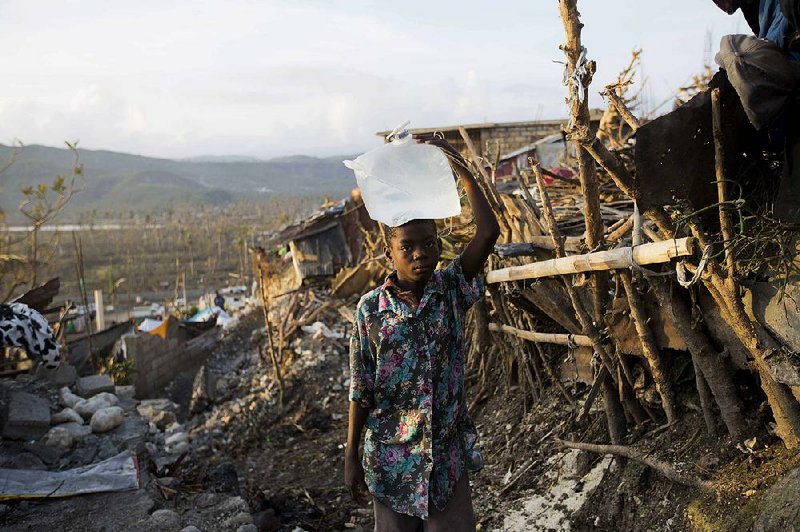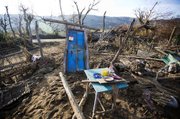MARFRANC, Haiti -- At a cramped police station serving as a makeshift clinic, Darline Derosier fastened IV drips to jail cell bars, wiped the brows of cholera patients and tended to the wounds of those injured when Hurricane Matthew slammed into Haiti's southwestern peninsula.
RELATED ARTICLE
http://www.arkansas…">Matthew's rains swell N.C. rivers to brim
She was the only health worker helping about 40 patients Monday inside the station bereft of police as she waited for help to arrive in the hard-hit town of Marfranc nearly a week after the Category 4 storm struck last Tuesday.
Among the patients was an elderly woman lying unconscious on a jail cell floor with a leg bandaged in an old rag and a man with gashes around his neck, his eyes fluttering.
"People will die soon if we don't get some aid," Derosier said.
[ MATTHEW’S IMPACT: Map of power outages, shelters]
[HURRICANE TRACKER: Follow Hurricane Matthew’s path so far]
The town is a 45-minute drive southwest from the coastal city of Jeremie, where food, medicine and fresh water were finally arriving but were still slow to reach increasingly desperate communities.
"We haven't received anything from Jeremie," Derosier said, adding that she has made several calls requesting help and medical supplies.
The United Nations humanitarian agency in Geneva made an emergency appeal Monday for nearly $120 million in aid, saying about 750,000 people in southwest Haiti alone will need "lifesaving assistance and protection" in the next three months. U.N. officials said earlier that at least 1.4 million people across the region need assistance and that 2.1 million people overall have been affected by the hurricane. About 175,000 people remain in shelters.
The Dutch government said Monday that it was sending a navy ship to Haiti to deliver aid including food, water and shelters and to check the ravaged nation's ports and waterways to ensure other aid vessels can safely dock in the aftermath of the storm.
In most places, electricity was still out, water and food were scarce, and officials said young men in villages along the road between the hard-hit cities of Les Cayes and Jeremie were building blockades of rocks and broken branches to halt relief convoys.
[WATCH: Video shows plane flying into eye of Hurricane Matthew]
A convoy of food, water and medicine was attacked by gunmen in a remote valley where there had been a mudslide, said Frednel Kedler, coordinator for the Civil Protection Agency in the Grand-Anse administrative district, which includes Jeremie.
The national Civil Protection Agency headquarters in Port-au-Prince raised the official nationwide death toll to 372, which included at least 198 deaths in Grand-Anse. But local officials have said the toll in Grand-Anse alone tops 500.
The U.N. also said the hurricane has increased the risk of a "renewed spike" in the number of cholera cases. A cholera outbreak since 2010 has already killed roughly 10,000 people and sickened more than 800,000.
Roosevelt Zamos of the Civil Protection Agency said there were 40 cases of cholera in Jeremie alone. He said eight people have died of cholera in Grand-Anse since the storm.
It can take from 12 hours to five days for cholera symptoms to appear after ingesting contaminated food or water, according to the World Health Organization.
The open-air cholera treatment center at Jeremie's main hospital had no running water Monday, and at least a dozen of the new patients were under age 10.
Etienne Chimene tried her best to soothe her 13-month-old son, Cenelson, who was lying in a wooden bed with a hole cut in it and a bucket underneath.
"I feel like my baby is getting worse," she said as she stroked his head and he whimpered.
The center was overcrowded, and patients who were improving were forced outside. Among them was 21-year-old Nedrine Cabane, who sat on the ground with her father. He had given her a pot of plantain soup that she ate gratefully -- her first meal in three days.
"The fact that there is so much dirty water around makes me think that more people are going to get sick," she said.
Dr. Thiery Francois, lead doctor for the Ministry of Health at the cholera center, said he didn't know how many new cases had been caused by the storm nationwide.
"Certainly there are cases we don't know anything about," he said, referring to still-isolated areas.
For now, though, Jeremie residents were more focused on the immediate problem of shelter.
Gary Guerrier, 36, a schoolteacher, saw the storm rip the metal roof off his house, leaving him, his wife and their week-old baby daughter exposed to the elements. After being driven back twice by the raging winds, he finally wrapped the infant in a bundle of bedsheets to protect her for the journey to a neighbor's house.
"I'm still in a state of shock," Guerrier said. "We're lucky we didn't lose anyone. But as for material things, I lost everything."
Jeremie, isolated and underdeveloped for decades, had recently seen signs of development, including new hotels and a robust coffee crop. But as so often in the past, whenever Haiti tries to pick itself up, something always seems to knock it back down, including, and perhaps especially, the forces of nature.
"In 2010, before the earthquake, we had a growth rate of 5.7 percent," said Jude Celestin, a presidential candidate who toured the devastated area Sunday afternoon. "It's the same in Jeremie. It was going up. People from Port-au-Prince were investing here."
As a crowd shouted in the background, trying to get closer to the candidate, Celestin looked around at the homes stripped to their foundations and the mounds of refuse piled up to his shoulders.
"And now, this," he said, shaking his head. "It's the way it is."
People in the southern seaside community of Les Anglais and surrounding areas said little to no aid had reached them by Monday.
An aid group tried to distribute food and other emergency supplies by boat Sunday, but it was forced to leave after a large crowd gathered.
"There were too many people fighting. They went to give it someplace else," Claude Pierre Louis, 63, said angrily as she washed pots in a plastic bucket on the porch of her house, which lost its roof during the storm.
She said Les Anglais needed building supplies because almost every house was damaged and most were destroyed. She added that people already had created a community group to help clear the streets of debris and rebuild on their own.
An estimated 158 people died in Les Anglais, said two police officers who declined to give their names because they were not authorized to talk to the media.
Francis Jean, a 42-year-old farmer and taxi driver, was awaiting help after he, his wife and three daughters survived the storm but lost their roof and all their belongings.
"You can't even explain what happened here. I've never seen anything like this in my life," he said. "This town doesn't exist anymore. There's nothing."
Information for this article was contributed by David McFadden, Ben Fox, Jamey Keaton and staff members of The Associated Press and by Azam Ahmed of The New York Times.
A Section on 10/11/2016

